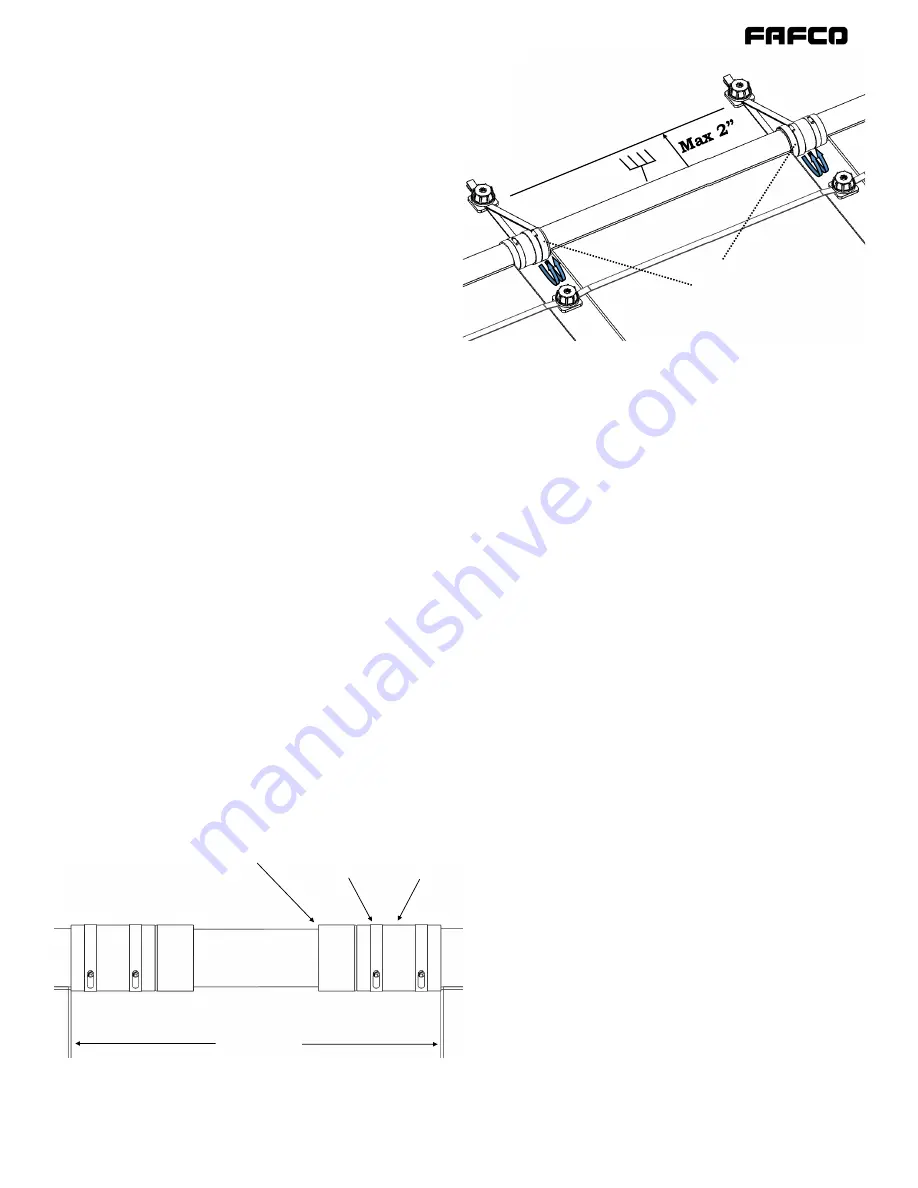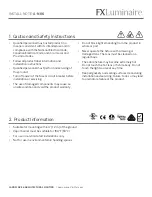
®
17
Obstacle Avoidance
PHASE II
—
System Installation Detail Cont’d
Connect Supply & Return Lines
5” EPDM hose couplers are used to make a semi flexi-
ble connection from a SunSaver
®
bank to Schedule 40,
2” PVC piping. Below is the best order to follow for con-
necting the supply and return lines:
1. Check that all supply lines are connected to the lowest
end of their collector row and that the upper ends feed
to a common high point in the system. (as in
Figure
5
).
2.
Connect 5” couplers on upper and lower inserts of
all collector corners for supply and return plumb-
ing. Be sure to install hose clamps as depicted in
Figure 9.
3. Route supply line to the bottom header of each row
4. Route the return line to the upper header of each
row.
5. If there are straight pipe runs in the plumbing ex-
ceeding 15ft without an offset, there must be either
a plumbing expansion kit installed or an industry
standard method to accommodate for any expan-
sion and contraction (see
Plumbing Layout
and
Ap-
pendix C
for details).
6. Both supply and return line plumbing must be
mounted so that it is allowed to move an equivalent
of 1/2” for every collector between it and the Fix
Mounted collector in the bank. If there are multiple
collectors, it may be advisable to install an Expan-
sion joint immediately in the plumbing so that
when the bank moves with temperature, the plumb-
ing will be able to absorb the movement immediate-
ly. Refer to
Plumbing Layout
and
Appendix C.
CAUTION: Overtightening Hose Clamps will deform
connectors and accelerate compression set in de-
formed EPDM hose and will lead to leaking. Torque
all hose clamps to 35-42 in-lbs.
Figure 10 | Adding Space to a Row
In order to accommodate for obstacles in a row, collectors may need
to be spaced out by adapting the couplers to PVC.
Collectors
PVC Pipe
Pipe
Adapter
Hose
Clamp
Coupler
Since the collectors are made of a polymer that sees
large temperature swings, there can be a lot of natural
movement in an array as well as all plumbing. If sim-
ple practices are not adhered to, this natural move-
ment can cause damage to solar collectors, plumbing
and roof penetrations.
As seen in
Phase I
,
Plumbing Layout
and
Appendix C,
SunSaver
®
banks move both laterally and longitudi-
nally along the roof. It’s often best to mount the mid-
point of the bank so that the movement is divided
evenly to both sides of the bank. This can be done by
double wrapping a header strap around the fixed col-
lector on both upper headers and installing the Caps/
Bases up to 2” away from the header (see
Figure 11
).
Use a means of fix-mounting this collector which best
fits the practices of installation company. The plumb-
ing end of the bank will move simply from the move-
ment of the bank which will then translate to the
plumbing. Since there can be movement translated to
the plumbing, it’s crucial to plumb the banks so that
this movement can either be absorbed in the coupler
or absorbed in the plumbing. To accommodate for
movement in the banks, all plumbing must be coupled
to the bank with a 5” coupler and if there is a long run
of plumbing going directly to the bank, accommoda-
tions for thermal expansion must be utilized. Refer to
the
Figures 16 and 20
in
Appendix C
.
Collectors may need to be spaced out to allow for mid-
bank obstacles or changes in roof shape. In most cas-
es, the banks will need to have additional spacing
added so that the bank can be plumbed around the
Figure 11|The Fix-Mounted Collector
On the
Fix-Mounted Collector
, the upper headers should be double
wrapped on both sides to keep the Collector as an inflection point of
bank movement. A means of limiting bank movement should be used
which best fits the practices of the installation company.
Double
Wrap
(Fixed Points)
















































